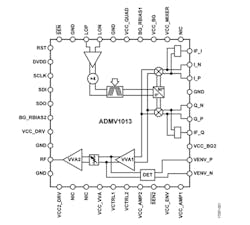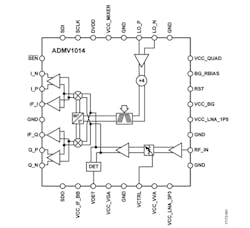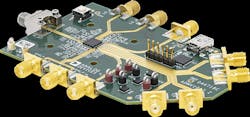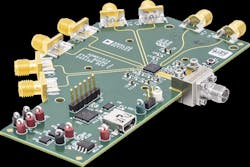Complementary Up/Downconverter ICs Hit 44 GHz for 5G (and More)
Whether your multi-gigahertz RF architecture is using an IF stage or a direct conversion to/from baseband approach, you’ll need upconversion and downconversion functions. However, implementing those functions while meeting the stringent performance specifications across multiple parameters becomes more challenging as the operating bands increase to the tens of gigahertz.
That’s where the ADMV1013 upconverter (Fig. 1) and ADMV1014 (Fig. 2) downconverter from Analog Devices can help, especially with (but not limited to) products and test/measurement-related design-in activity focused on the 5G mmWave bands at 28 GHz and 39 GHz. The ICs cover 24 GHz to 44 GHz with a 50-Ω impedance match, thus reducing the time, effort, and cost of developing a single platform that can support multiple bands.
1. The ADMV1013 upconverter IC from Analog Devices is a highly integrated SiGe RF IC, providing key signal-chain functions to 44 GHz.
2. The complementary ADMV1014 downconverter IC is also highly integrated and designed to provide the somewhat similar reverse signal-chain functions as the upconverter.
Other application areas include satellite and earth-station broadband-communication links, aircraft radios, RF test equipment, and radar systems. The flexibility, minimal need for external components, and ease of use of these ICs makes them a good match with constrained form-factor systems such as small cells.
The converters can be used for direct conversion to/from baseband (from dc to 6 GHz) or to an IF (800 MHz to 6 GHz), due to their I (in-phase) and Q (quadrature-phase) mixers with an on-chip programmable quadrature phase-shifter configurable for either mode. Based on SiGe process technology, these highly integrated, complementary devices are more than just up/downconverter cores. They also include voltage-variable attenuators, a transmit PA driver (upconverter) or a receive LNA (downconverter), local-oscillator (LO) buffers with ×4 frequency multiplier, and programmable tracking filters.
Their flat, 1-GHz RF instantaneous bandwidth supports a wide range of broadband and ultra-wide bandwidth transceiver applications. In addition, the upconverter’s >20-dBm OIP3 specification supports stringent modulation schemes such as 1024-QAM.
An SPI interface is used to control most functions and settings, as well as to adjust the quadrature phase-imbalance of either converter for optimum sideband suppression (usually a difficult proposition) and LO nulling. This enables improvement in suppression of sideband emissions by 10 dB or more from their 32-dBc typical value.
3. Setting up a circuit at tens of gigahertz mandates careful attention to layout details, materials, connectors, signals, and evaluation tools. A vendor-evaluation board such as this one for the ADMV1013 upconverter can be a significant help.
4. Complementing the ADMV1014 upconverter evaluation board, this board for the ADMV1014 downconverter should greatly speed design-in and setup, as well as performance adjustments and assessment.
Any IC (or module) intended for operation at these frequencies needs significant design-in support. To this end, Analog Devices offers the EVAL-ADMV1013 and EVAL-ADMV1014 evaluation boards (Figs. 3 and 4, respectively), along with a User Guide, evaluation software, USB drivers, Gerber files, and S-parameter files.
Samples and production quantities are available immediately. The ADMV1013 ($90.79/1000-piece lots) is offered in a 40-pin, 6- × 6-mm LGA package, while the ADMV1014 ($88.37/1000-piece lots) is in a 32-pin, 5- × 5-mm LGA package.
About the Author

Bill Schweber
Contributing Editor
Bill Schweber is an electronics engineer who has written three textbooks on electronic communications systems, as well as hundreds of technical articles, opinion columns, and product features. In past roles, he worked as a technical website manager for multiple topic-specific sites for EE Times, as well as both the Executive Editor and Analog Editor at EDN.
At Analog Devices Inc., Bill was in marketing communications (public relations). As a result, he has been on both sides of the technical PR function, presenting company products, stories, and messages to the media and also as the recipient of these.
Prior to the MarCom role at Analog, Bill was associate editor of their respected technical journal and worked in their product marketing and applications engineering groups. Before those roles, he was at Instron Corp., doing hands-on analog- and power-circuit design and systems integration for materials-testing machine controls.
Bill has an MSEE (Univ. of Mass) and BSEE (Columbia Univ.), is a Registered Professional Engineer, and holds an Advanced Class amateur radio license. He has also planned, written, and presented online courses on a variety of engineering topics, including MOSFET basics, ADC selection, and driving LEDs.





